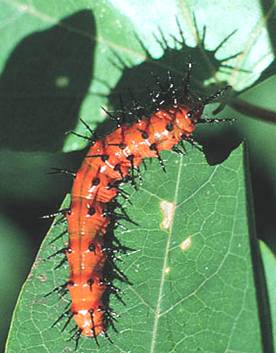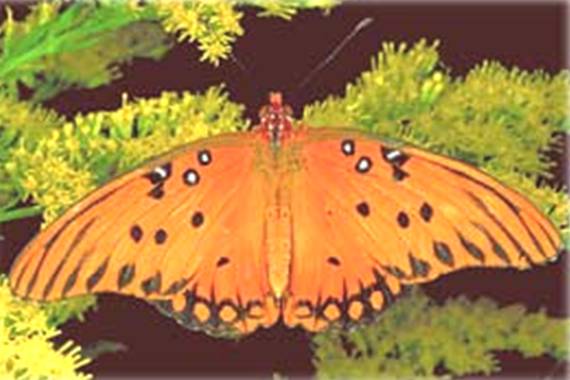Gulf Fritillary
Agraulis vanillae
Description: 2.75 to 3.75" wingspan with wings very wide compared to length. This is a member of the longwing family. Its range is throughout the southern half of the United States with occasional strays further north. It prefers open, sunny areas and disturbed sites such as old fields, roadsides, meadows, pastures, and fallow agricultural land.
Larval Host Plants: Various passionflower vines including maypop (Passiflora incarnata), blue passionflower (P. caerulea), and corky-stemmed passionflower (P. suberosa)
Favorite Adult Nectar Sources: Tall verbena (Verbena bonariensis), pentas (Pentas lanceolata), tread softly (Cnidosculous stimulosus), drummond phlox (Phlox drummondii), and lantana (Lantana camara) The Gulf Fritillary prefers to lay single eggs on plants that are in the bright sun while the Zebra Longwing prefers the same plants only in the shade. Zebra Longwings also lay eggs in clusters.
The Gulf fritillary is a medium-sized, orange butterfly with black markings and somewhat elongated wings. Its hindwings below are covered with numerous silvery, aluminum-like patches that distinguish this butterfly from the similar and equally common monarch. Fond of open, disturbed sites, the Gulf fritillary frequently stops to nectar at colorful flowers and is a very common garden visitor. The Gulf fritillary is one of several migratory species in the Southeast. As fall approaches, adults begin a mass southward migration eventually arriving in the warm confines of South Florida to overwinter.
Female Gulf fritillaries lay small, yellow eggs singly on the leaves or tendrils of the host plant. The mature larva is bright orange with conspicuous black spines. Although the larvae are solitary feeders, they often occur in very large numbers and can quickly defoliate passionflower vines. For this reason, gardeners may wish to occasionally "thin" or remove some larvae to insure that there is enough food to go around for the other hungry mouths, and enough leaves to keep the vine alive. The pupa (or chrysalis) is light brown and closely resembles a dead leaf.
When is a Fritillary not a Fritillary? The gulf fritillary is a longwing even though it is called a fritillary due to similar colorations.





